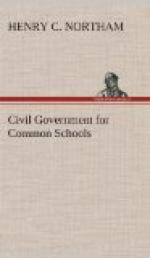Q. What Convention is held next?
A. The National Convention. The delegates then and there assembled nominate candidates for the offices of President and Vice-President; and adopt their political platform.
Q. When do these conventions just named take place?
A. Once in four years, in the months of April, May and June, preceding the presidential election.
Further actions by political parties.
I. State Convention for nominating
the Electors for President
and Vice-President.
II. Voting for these Electors at
the annual election.
Q. When does the State Convention for nominating the Electors meet?
A. At a time when it is convenient to nominate State officers: for instance, August or September.
Q. To how many Electors is each State entitled?
A. As many as it has Representatives and Senators. For instance, New York has thirty-three Representatives in the House, and two Senators; therefore New York is entitled to thirty-five electoral votes. Colorado has one Representative, and two Senators, and is entitled to three electoral votes.
Q. How are these Electors distributed about the State?
A. One Elector is elected for each Congressional District; the two others are called Electors at Large, and are selected from any part of the State.
Q. What must each political party do that it may get its candidates before the people?
A. It must have its conventions and nominate the required number of Electors.
Q. What are these Electors intended to represent?
A. The views of the party nominating them.
O. How frequently, and when is a Presidential election held?
A. Once in four years, on the Tuesday following the first Monday in November, throughout all the States.
Q. What must each voter do, in the State of New York, that he may cast a ballot for President and Vice-President?
A. He must hand to the inspectors of election a ballot upon, which is printed the names of the thirty-five Electors.
Q. By whom are these votes to be canvassed (or counted)?
A. By the same officers that canvass other votes. In New York State the inspectors of election canvass for their respective election districts, and certify the same to the Board of County Canvassers; the County Canvassers canvass for counties, and certify to the State Canvassers; the State Canvassers canvass for the State; and the Executive authority of each State causes three lists of the Electors of such State to be made and certified and delivered to the said Electors, on or before the first Wednesday in December.
Meeting of presidential electors.
Q. What must the Electors that have been declared elected then do?
A. I. They must meet on the first Wednesday in December succeeding their election, at such place in each State as the Legislature thereof shall designate (usually the capital), and vote for President and Vice-President, one of whom shall not be an inhabitant of the same State with themselves.




